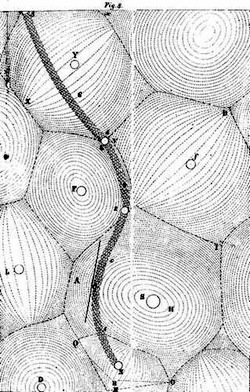René Descartes, Paris, 1654 (Google Books, 1664)
Descartes’ work was composed between 1629 and 1633, but he did not publish it in his lifetime, due to fear from church authorities.
His main aim was ‘to establish that the cause of light is motion’, a goal that required formulating ‘an explanation of qualities, a theory of matter, laws of motion, an explanation of the heavens, and a theory of perception’. 1 As part of his matter theory, he published a definitive account of his mechanical philosophy, in which all things were composed of corpuscles of matter in a plenum, or a ‘full’ universe of finer and finer particles that swirled in vortices.

The contents of the work were:
- On the Difference Between our Sensations and the Things That Produce Them
- In What the Heat and Light of Fire Consists
- On Hardness and Liquidity
- On the Void, and How it Happens that Our Senses Are Not Aware of Certain Bodies
- On the Number of Elements and on Their Qualities
- Description of a New World, and on the Qualities of the Matter of Which it is Composed
- On the Laws of Nature of this New World
- On the Formation of the Sun and the Stars of the New World
- On the Origin and the Course of the Planets and Comets in General; and of Comets in Particular
- On the Planets in General, and in Particular on the Earth and Moon
- On Weight
- On the Ebb and Flow of the Sea
- On Light
- On the Properties of Light
- That the Face of the Heaven of That New World Must Appear to Its Inhabitants Completely like That of Our World
For an amusing overview of Cartesian philosophy, see here.
- Margeret Osler, ‘Descartes Optics: Light, the Eye, and Visual Perception’, in A Companion to Descartes, ed., Janet Broughton, John Carriero (Chicester: Wiley, 2008), 125. ↩

